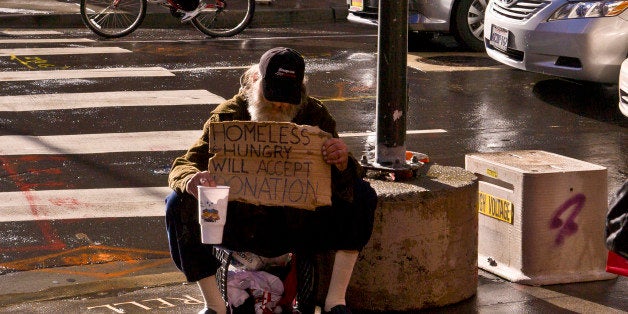
Have we been thinking about panhandlers all wrong?
The question of how to address the problem of panhandlers -- a common sight in many major American cities -- is a complicated and often controversial topic.
In an effort to shed some light on the issue, a San Francisco's Union Square Business Improvement District commissioned a survey of the panhandlers in its 27-block district, and the results of may surprise you.
Of the 146 people questioned by GLS Research, the majority said they use any donations for food, spend seven days a week out on the streets and earn less than $25 a day, according to the San Francisco Chronicle.
A demographic breakdown of those surveyed skewed toward middle-aged men, 48 percent of whom were African American, 31 percent of whom were white and 62 percent of whom are disabled.
These findings, while specific to a relatively small sample population, would seem to contradict some of the most popular myths about panhandlers, Think Progress' Scott Keyes suggests.
"Conventional wisdom is that those on the sidewalk asking for a dollar are lazy freeloaders who will use the money for alcohol or drugs," Keyes notes. "Some even think that beggars are living large off of handouts."
While the survey notes that some panhandlers are addicts -- with 25 percent of respondents admitting to being an alcoholic, and 32 percent reporting an addiction to drugs -- the idea of panhandlers living large is often perpetuated by periodic reports of "affluent" beggars like Shane Warren Speegle, an Oklahoma City man who told police he made $60,000 panhandling.
The notion is also a talking point for conservative commentators like Fox Business host John Stossel, who once posed as a homeless person in an effort to prove that panhandlers were "freeloaders" who were making big bucks on the streets.
“I had heard that some people beg for a living and can make big bucks, $80,000 a year in some cases,” Stossel told the co-hosts of "Fox & Friends" in July 2012. “I made at a rate of about $24,000 — tax free. I just did it for a couple hours."
The GLS Research survey, however, found that 60 percent of the panhandlers surveyed reported making $25 a day or less, a rate that adds up to much less than Stossel's figure of $24,000 per year.
In fact, when the rate is averaged across an eight-hour workday, the San Francisco panhandlers reported making over $3 an hour, which is roughly $5 less than California's minimum wage and $9.83 dollars less than San Francisco's "living wage," as calculated by researchers at the Massachusetts Institute of Technology.
But just as Stossel's "experiment" is not indicative of panhandlers in general, it may be unwise to extrapolate too much from the San Francisco survey results. As one Detroit Free Press article points out, different regions may have different types of panhandlers in different degrees of distress.
For now, the San Francisco mayor's office says it will be reviewing the data collected by the researchers.
"People have scary experiences on the streets. I don't want to minimize that at all," Amanda Fried, director of policy for the mayor's homeless office, told the Chronicle. "But behind a lot of that are people who are very sick and need our help."